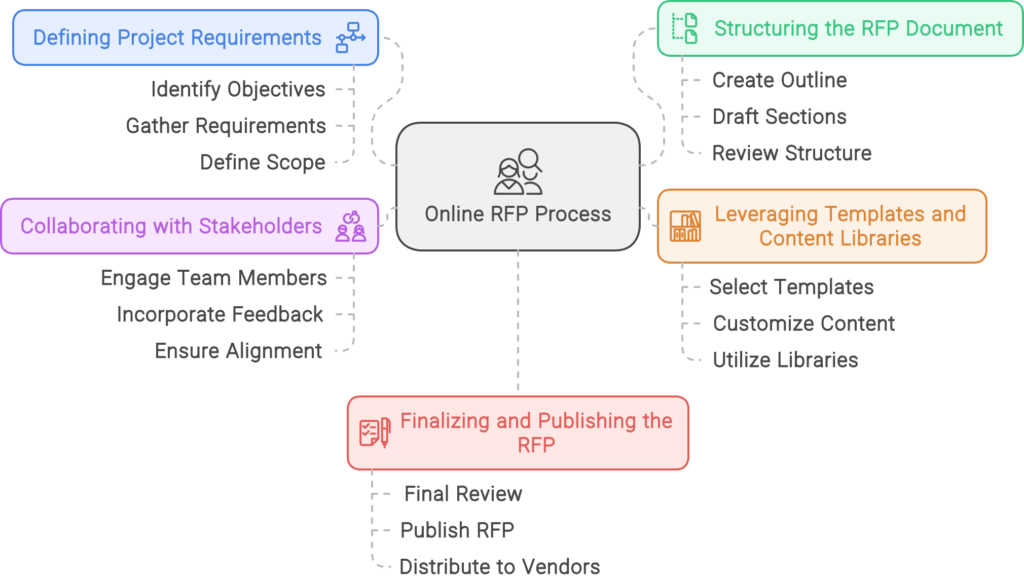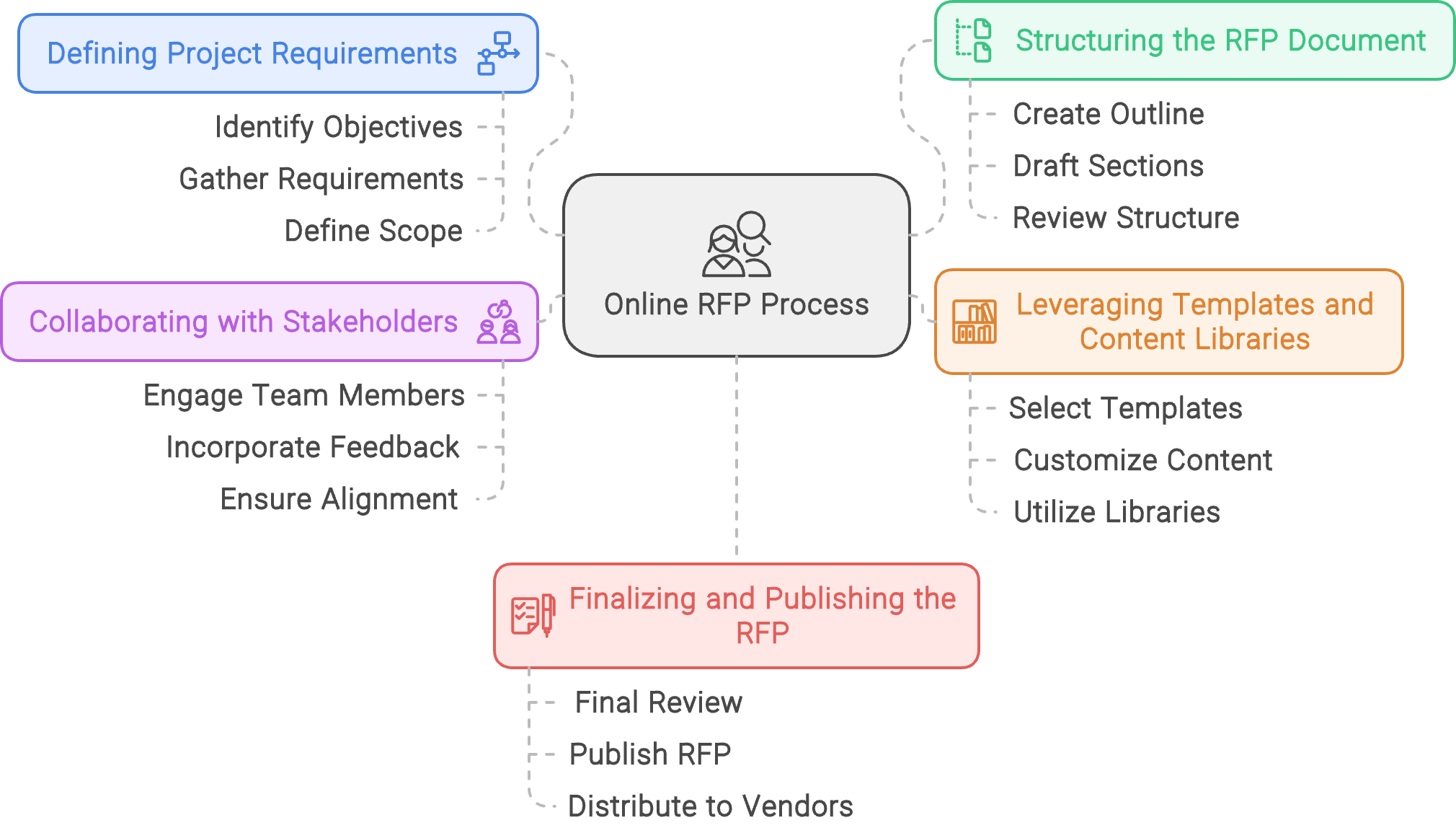Request for Proposals (RFPs) are a key part of how companies find and choose suppliers. They help businesses clearly state what they need and figure out which vendors can do the job best. Creating good RFPs is essential for getting the right suppliers and making smart buying decisions.
When you excel at making RFPs, it can save your company time and money. It also helps ensure you’re picking the best suppliers for what you need. In this guide, we’ll show you how to use Krinati’s eSourcing tools to make great RFPs step by step.
Key Benefits of Using Krinati’s eSourcing Tools
- Faster RFP Creation and Management: Save up to 70% of time spent on manual processes
- Improved Supplier Selection: AI-powered analysis to identify the best fit for your organization
- Cost Savings: Strategic sourcing can lead to 10-20% cost savings through optimized procurement
- Better Collaboration: Facilitate real-time communication among team members
- Increased Transparency and Compliance: Ensure a clear and auditable process
- Data-Driven Insights: Enable continuous improvement through RFP performance analysis
Understanding the RFP Process
Before we discuss how to make an RFP, let’s talk about what goes into a good one. A solid RFP should clearly state what you need, when you need it by, and how you’ll pick the winner. It should also give suppliers all the information they need to make a good offer.
Making RFPs can be challenging. Sometimes it’s difficult to explain exactly what you want, or you might not get enough good responses. Using digital tools for RFPs can help address these problems and simplify the whole process.
A well-structured RFP typically includes sections such as project overview, scope of work, timeline, evaluation criteria, and submission instructions. It’s important to be as specific as possible to avoid misunderstandings and ensure you receive relevant proposals.
The Role of eSourcing in Modern RFP Management
eSourcing tools are changing how companies handle RFPs. These digital tools make it faster and easier to create, send out, and manage RFPs. They help keep everything organized and make it simpler for suppliers to respond.
With eSourcing, you can make RFPs more quickly and keep track of them better. It also makes it easier for different people in your company to work together on RFPs. Using these tools can help you save money and pick better suppliers.
eSourcing platforms like Krinati’s offer features such as automated workflows, real-time collaboration, and centralized document management. These features not only streamline the RFP process but also enhance transparency and compliance.
Krinati’s eSourcing Solution: An Overview
Krinati’s eSourcing tools are designed to make RFP creation and management straightforward. They offer features like templates for quick RFP creation, tools for team collaboration, and ways to easily compare supplier responses. These tools can work with other systems your company already uses, making it simple to fit into your current way of doing things.
Krinati’s eSourcing solution helps you manage the whole RFP process from start to finish. It makes it easier to create clear, detailed RFPs and helps you pick the best suppliers based on what matters most to your company.
One of the standout features of Krinati’s solution is its AI-powered analysis capabilities. This technology can help you identify patterns and insights in supplier responses that might be missed by manual review. Additionally, the platform offers robust reporting tools that allow you to track key performance indicators (KPIs) throughout the RFP process, enabling continuous improvement.
Step-by-Step Guide to Creating an RFP with Krinati’s Tools

5.1. Defining Project Requirements
First, you need to figure out exactly what you’re looking for. Use Krinati’s tools to list out all your needs and wants for the project. This might include things like what the product or service should do, when you need it by, and how much you’re willing to spend.
The clearer you are about what you need, the better responses you’ll get from suppliers. Krinati’s tools can help you organize these requirements in a way that’s easy for suppliers to understand.
Consider using Krinati’s requirement builder feature, which guides you through a series of questions to help define your project needs comprehensively. This tool can help ensure you don’t overlook any critical aspects of your project requirements.
5.2. Structuring the RFP Document
Now it’s time to put your RFP together. Krinati’s tools have templates that can help you organize your RFP in a logical way. This usually includes sections like an introduction to your company, a detailed description of what you need, how you’ll choose the winner, and any rules suppliers need to follow.
Using a clear structure helps make sure you don’t forget anything important and makes it easier for suppliers to respond to your RFP.
Krinati’s RFP builder offers customizable sections, allowing you to tailor the document structure to your specific needs. You can also save custom templates for future use, streamlining the process for similar projects.
5.3. Leveraging Templates and Content Libraries
Krinati’s eSourcing tools come with pre-made templates and a library of content you can use. These can save you a lot of time when you’re making your RFP. You can use these as a starting point and then change them to fit your specific needs.
The content library can be especially helpful for parts of the RFP that don’t change much from one project to another, like company information or standard terms and conditions.
Take advantage of Krinati’s industry-specific templates, which are designed to address common requirements in various sectors. These templates can help ensure you’re asking the right questions and covering all necessary aspects for your particular industry.
5.4. Collaborating with Stakeholders
Making an RFP often involves input from different people in your company. Krinati’s tools make it easy for team members to work together on the RFP. You can share drafts, get feedback, and make changes all in one place.
This collaboration feature helps make sure everyone agrees on what’s in the RFP before you send it out to suppliers.
Krinati’s platform offers role-based access control, allowing you to define who can view, edit, or approve different sections of the RFP. This ensures that the right people are involved at the right stages of the process, maintaining security and compliance.
5.5. Finalizing and Publishing the RFP
Once your RFP is ready, you can use Krinati’s tools to do a final check and then send it out to suppliers. The system can help you keep track of which suppliers have received the RFP and when responses are due.
You can also use the tools to answer any questions suppliers might have about the RFP, making sure everyone has the same information.
Krinati’s platform includes a built-in Q&A module, allowing suppliers to submit questions directly through the system. This centralizes all communication and ensures that all potential bidders have access to the same information, promoting fairness and transparency in the process.
Enhancing RFP Quality with AI-Powered Suggestions
Krinati’s eSourcing tools use artificial intelligence (AI) to help make your RFPs even better. The AI can suggest ways to improve your RFP based on what’s worked well in the past. It can help you use the right words to clearly explain what you need.
As you use the system more, the AI learns and gets better at giving helpful suggestions. This can help you create RFPs that are more likely to get good responses from suppliers.
The AI-powered suggestions in Krinati’s platform can also help identify potential gaps or inconsistencies in your RFP. It might suggest additional questions to ask or highlight areas where more detail could be beneficial. This feature acts like a virtual procurement expert, helping to refine and improve your RFPs over time.
Streamlining Supplier Management through eSourcing
Managing suppliers can be a big job, but Krinati’s tools make it easier. You can keep all your supplier information in one place, making it simple to find the right suppliers for each RFP. The system can also help you keep track of how well suppliers have done in the past.
When you get responses to your RFP, Krinati’s tools can help you compare them easily. You can set up scoring systems to help you evaluate each response fairly. This makes it easier to pick the best supplier for your needs.
Krinati’s supplier management module includes features for supplier onboarding, performance tracking, and risk assessment. This comprehensive approach to supplier management can help you build stronger, more strategic relationships with your key vendors.
Maximizing Transparency and Governance in RFP Processes
It’s important to keep good records of your RFP process. Krinati’s tools automatically keep track of changes made to the RFP and who made them. This helps make sure everything is done fairly and follows your company’s rules.
The system also makes it easy to show how you picked a supplier if anyone asks. This can be really helpful if you need to explain your decision to company leaders or if there’s ever an audit.
Krinati’s platform offers detailed audit trails and reporting capabilities, allowing you to demonstrate compliance with internal policies and external regulations. This level of transparency can help build trust with stakeholders and reduce the risk of procurement-related issues.
Accelerating RFP Cycle Times with Krinati’s Tools
One of the big benefits of using Krinati’s eSourcing tools is that they can speed up the whole RFP process. The system can automatically assign tasks to different team members and send reminders when things are due. This helps keep the process moving along smoothly.
The tools also make it easy for team members to work together in real-time, even if they’re in different places. This can really speed things up compared to sending emails back and forth.
Krinati’s workflow automation features can significantly reduce the time spent on administrative tasks. For example, the system can automatically send notifications to approvers when their input is needed, or alert suppliers when new information is available. These time-saving features allow your team to focus on more strategic aspects of the RFP process.
Achieving Cost Savings through Strategic Sourcing
Strategic sourcing is all about finding ways to save money while still getting what you need. Krinati’s tools can help with this by making it easier to create competitive RFPs. When suppliers know they’re competing with others, they often offer better prices.
The tools can also help you use something called the Kraljic Matrix. This is a way of looking at what you’re buying and figuring out the best strategy for each type of purchase. Using this method can help you save money and build better relationships with your suppliers.
Krinati’s platform includes advanced analytics tools that can help you identify cost-saving opportunities. For example, it can analyze historical pricing data to help you set realistic budget expectations, or identify opportunities for consolidating purchases across different departments. These insights can lead to significant cost savings over time.
Measuring Success: Analytics and Insights in RFP Management
To know if your RFP process is working well, you need to measure it. Krinati’s tools can help you track important things like how long the RFP process takes, how many good responses you get, and how much money you’re saving.
By looking at this data, you can see what’s working well and what could be better. This can help you keep improving your RFP process over time.
Krinati’s analytics dashboard provides real-time insights into your RFP performance. You can track KPIs such as supplier response rates, average time to award, and cost savings achieved. These metrics can help you demonstrate the value of your procurement efforts to stakeholders and identify areas for continuous improvement.
Conclusion: Embracing Digital Transformation in RFP Creation
Using digital tools like Krinati’s eSourcing solution can really improve how you create and manage RFPs. These tools can help you save time, pick better suppliers, and save money. They also make the whole process more transparent and easier to manage.
As more companies start using digital tools for RFPs, those who don’t might find it harder to keep up. By mastering RFP creation with tools like Krinati’s, you can help your company stay competitive and make smarter buying decisions.
The future of procurement lies in embracing digital transformation. Krinati’s eSourcing solution offers a comprehensive platform to streamline your RFP processes, enhance collaboration, and drive strategic decision-making. By leveraging these advanced tools, you can position your organization at the forefront of modern procurement practices, ready to tackle the challenges and opportunities of today’s fast-paced business environment.



